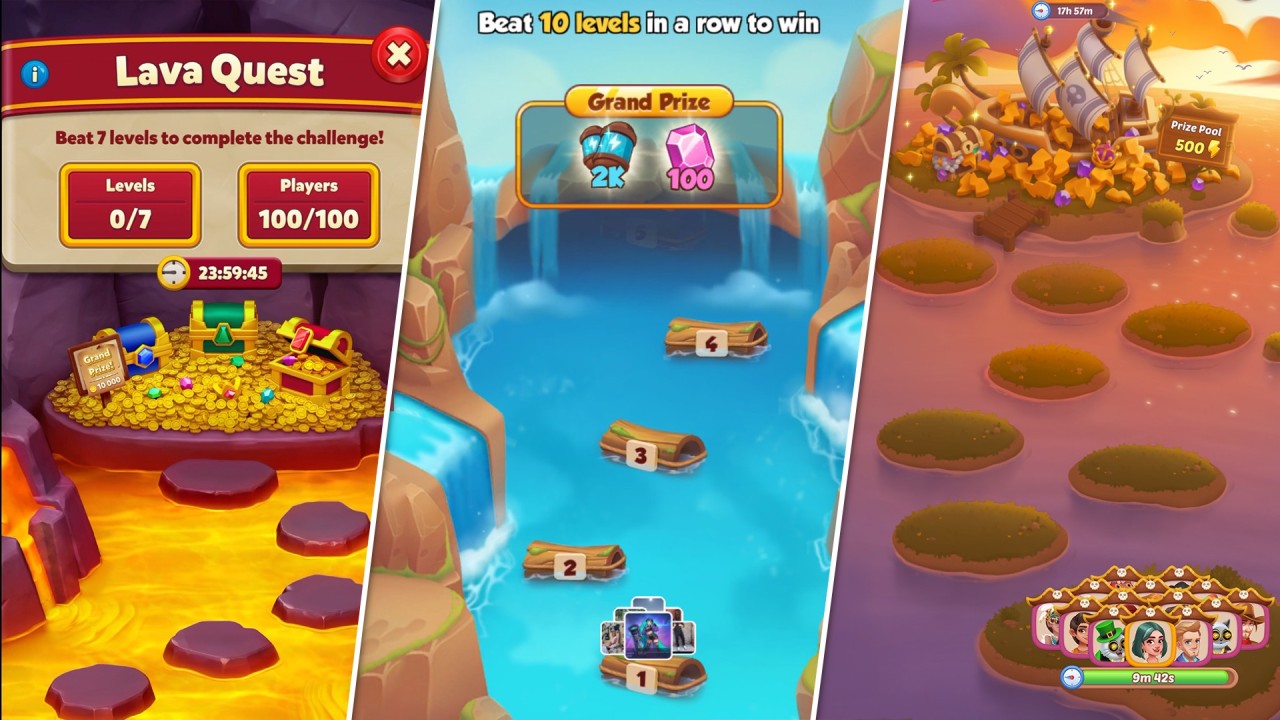About the author
Michael Kopelovich
I deliver weekly insights on game monetization strategies, reviews with a focus on revenue, and tips on marketing and creative design.

Journal 334 Michael Kopelovich September 25

Co-written by Michael Kopelovich & Constantin-Alexandru Iorga
The Lava Quest event has gained prominence as a Tier 1 live-ops event that blends competition, excitement, and clever psychological motivators to keep players engaged. Inspired by the battle royale mechanic, similar to Candy Crush’s “Candy Royale,” Lava Quest has become a popular feature in match-3 games, including Royal Match. Although we may be a bit late to the party as this event has been running for quite some time, its popularity hasn’t waned—on the contrary, it has continued to grow and expand into other games and genres.
This is why Constantin-Alexandru Iorga and I thought it would be interesting to break down the psychological aspects and design mechanics of Lava Quest, examining how it drives engagement and monetization. In this article, we’ll explore the core mechanics of Lava Quest, its psychological triggers, and how it can serve as a resource sink for developers.

Lava Quest is a time-limited event where players must beat seven consecutive levels on their first try. Players are placed in a group of 100, and only those who successfully clear all seven levels will share the grand prize of 10,000 coins. The challenge must be completed within 24 hours, creating a strong sense of urgency. Players who fail even one level are eliminated from the event, which increases the stakes and keeps players focused on maintaining a perfect streak.
Key aspects include:

One of Lava Quest’s key strengths is its effective use of the “carrot on a stick” approach. Progress is designed to continuously build anticipation, with each successfully completed level drawing the player closer to the event’s ultimate reward. This progressive structure compels players to focus intently on completing each stage, keeping them invested throughout the event.
This ties directly into the Sunk Cost Fallacy, a psychological principle that becomes more pronounced as players progress. The more resources players spend on boosters and currency to advance, the harder it becomes for them to walk away, even if the final reward may not justify the expenditure. The idea of abandoning the quest after significant investment becomes emotionally and psychologically painful, reinforcing the need to continue playing.

Lava Quest cleverly operates as a resource sink. Players often use in-game resources like boosters and currency to stay in the event, particularly as they near the final levels. This resource expenditure grows as players strive to maintain their streak, making the emotional investment in the event even deeper.
This creates a twofold effect:
Lava Quest builds tension and excitement through its competitive structure. Starting with 100 players, the event continuously tracks the number of survivors after each level. As the player pool diminishes, the grand prize becomes more valuable, intensifying players’ drive to continue.
The presence of a hard level during the event serves as a key turning point, where many players are often eliminated. This difficulty spike typically happens in the second half of the event, where the stakes are highest, and it triggers a powerful surge in loss aversion. Players who are close to finishing but at risk of elimination will be motivated to spend whatever resources they have left—boosters or in-game currency—to avoid failure. As players get closer to the prize, the frustration of potentially losing all their progress grows, making them more likely to make in-app purchases to guarantee success.

Lava Quest leverages several psychological triggers, with the Sunk Cost Fallacy being one of the most powerful. As Alex pointed out, this mechanism pushes players to invest even more in the event once they’ve already spent resources, particularly if they’re at risk of losing in the later levels (6 or 7).
The closer players get to the prize, the more they are driven by the fear of losing all their invested resources. They perceive their progress as being sunk if they don’t complete the event, and this feeling of loss aversion can lead to in-app purchases as players scramble to secure their victory. This sense of urgency is magnified by the event’s time-limited nature, where players feel the pressure to finish before time runs out.
While this dynamic can result in a net loss of resources for players, as the value of the boosters and currency spent often outweighs the final prize, the psychological satisfaction of winning the event often outweighs practical considerations. Players are more focused on the emotional victory and the thrill of completing the event than on the actual rewards.

Although Lava Quest does a great job of engaging players, there are additional monetization opportunities that could enhance the event’s revenue potential. For example:
Lava Quest is a brilliant example of how live-ops events can blend competition, player psychology, and resource management to create a compelling experience. By leveraging the Sunk Cost Fallacy and loss aversion, the event keeps players deeply invested, often leading them to spend more resources to avoid failure. As mobile game developers continue to innovate with live-ops events, Lava Quest offers a valuable case study on how to effectively drive both player engagement and monetization. Whether through its competitive structure, the “carrot on a stick” approach, or its ability to act as a resource sink, Lava Quest remains one of the most fascinating and engaging live-ops events in the mobile gaming space.
About the author
I deliver weekly insights on game monetization strategies, reviews with a focus on revenue, and tips on marketing and creative design.
Please login or subscribe to continue.
No account? Register | Lost password
✖✖
Are you sure you want to cancel your subscription? You will lose your Premium access and stored playlists.
✖